Metal containers with tight-fitting lids are your best choice for keeping wood ash fresh during curing. You'll want a five-gallon container that can hold about 20 pounds of ash from one cord of wood, made from stainless steel or galvanized metal to prevent chemical reactions. Don't use aluminum, plastic, or wooden containers as they can degrade or react with the ash. Place your container on a non-combustible surface at least three feet from flammable materials, and make certain it has proper ventilation to control moisture. Understanding proper container selection is just the first step in mastering the ash curing process.
Metal Container Benefits

Metal containers stand out as the safest choice for storing wood ash, primarily due to their fire-resistant properties. When you're dealing with wood ash that may contain hidden live embers, a metal container with a tight-fitting lid effectively chokes out any remaining fire risk. The secure lid closure ensures oxygen cannot sustain potential embers.
You'll find that metal's durability makes it particularly suited for this task, as it won't deteriorate when exposed to outdoor conditions.
You can count on a metal container's practicality in your daily maintenance routine. They're easier to clean than other materials, and if you choose one with a sturdy handle, you'll have no trouble moving it to your designated storage area.
When you're selecting your container, make sure it's large enough to accommodate your needs but still manageable to lift when full.
For ideal safety, you'll want to place your metal container at least three feet away from any combustible surfaces, preferably on a cement or brick surface.
Don't forget to check your container regularly for signs of wear, as maintaining its integrity is essential for safe ash storage.
You'll appreciate how a well-chosen metal container simplifies the entire ash management process.
Ideal Container Size Guidelines
When selecting a container for wood ash storage, you'll want to start with a five-gallon pail size, which typically holds around 20 pounds of ash from a standard cord of wood. This size provides adequate capacity for most household wood-burning needs while remaining manageable for transport and handling.
If you're burning more wood, you can opt for larger containers, but make certain they maintain proper coverage and security. For safe storage, containers should be placed on packed soil to prevent any environmental contamination.
You'll need to take into account your woodstove or fireplace's ash production rate when choosing your container size. Select a container that won't overflow between emptying sessions, making it easier to maintain and transport. The container should have enough room to accommodate the ash without becoming too heavy or unwieldy.
When measuring your container needs, factor in the space required for safely covering the ash and preventing dust dispersion. Your container shouldn't be filled to the brim – leave enough room to secure the lid properly.
If you're storing ash from multiple cords of wood, you might want to use multiple five-gallon containers rather than one large one, making it easier to manage and distribute the ash when needed.
Proper Lid Selection
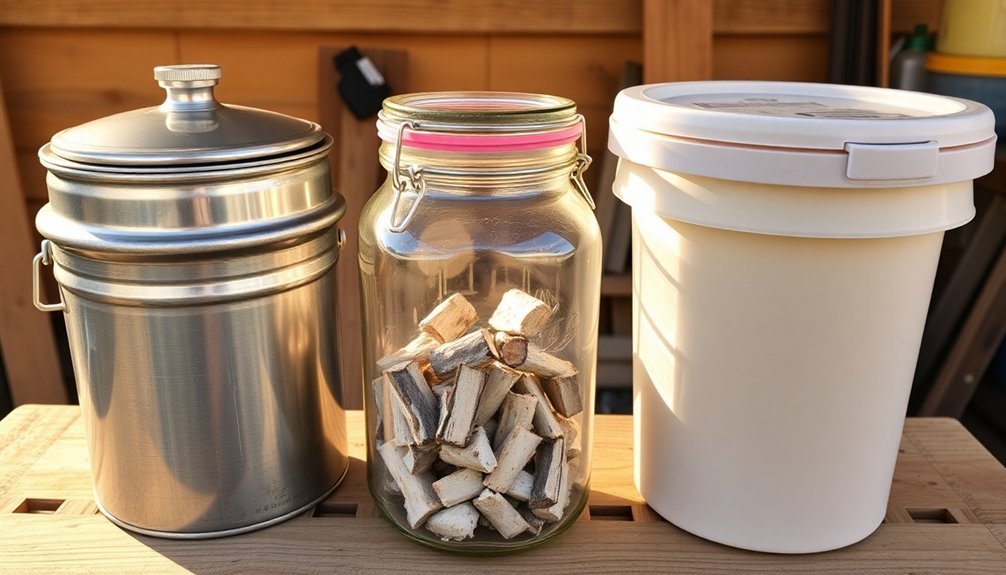
When selecting a lid for your wood ash container, you'll want to focus on tight-fitting seals that lock securely to prevent any ash from escaping or moisture from entering.
Your lid should be made of durable, weather-resistant metal that can withstand outdoor conditions and temperature fluctuations without warping or corroding. Galvanized metal lids are particularly popular for their durability and rust resistance.
To maintain ideal lid performance, regularly check the seal integrity, clean any ash residue from the edges, and lubricate hinges or locking mechanisms as needed.
Secure Sealing Methods
Proper lid selection stands at the forefront of safe wood ash storage. You'll want to focus on threaded lids for metal containers, as they provide the most secure seal.
When selecting a lid, verify it fits snugly and can be properly sealed using appropriate adhesives or sealants compatible with your container's material.
For peak sealing, you'll need to choose the right method based on your container type. Metal containers work best with silicone epoxy or metal glue, while wooden containers require wood glue or caulk. If you're using stone or marble urns, plumber's tape can provide additional protection against leaks.
- Always test the lid's fit before applying any sealant
- Apply a thin, continuous bead of sealant around the edge
- Let the sealant cure completely before moving the container
- Check for any gaps or weak spots in the seal
- Verify that handles and fastening mechanisms are intact
For containers with removable panels, secure them firmly with screws and add an extra layer of sealant if needed.
Remember that proper sealing not only keeps your wood ash fresh but also prevents unwanted spills and potential safety hazards.
Double-check all seals periodically to maintain effectiveness.
Weatherproof Lid Materials
Selecting weatherproof lid materials represents a critical step in protecting your stored wood ash from moisture and environmental damage.
Metal lids, particularly those made from stainless steel or galvanized steel, offer superior durability and create an excellent seal to prevent smoke and odors from escaping. You'll need to maintain them regularly to prevent rust, but they're ideal for handling high temperatures.
If you're looking for an aesthetically pleasing option, ceramic lids provide a good seal while resisting corrosion better than metal. However, you'll want to handle them carefully as they're more susceptible to breakage and mightn't be suitable for hot ashes.
Plastic lids offer a lightweight, cost-effective solution, but you'll need to verify they're made from heat-resistant and UV-stable materials. While they're easier to handle, they won't provide the same tight seal as metal or ceramic options.
Composite lids combine multiple materials for enhanced performance, offering a balance between looks and functionality.
Though they're typically more expensive and require additional maintenance, you'll benefit from their versatility and improved durability compared to single-material options.
Lid Maintenance Tips
To guarantee the longevity of your ash container, regular maintenance up and down the lid's components stands as a critical safety practice.
You'll need to inspect your lid frequently for signs of wear, damage, or warping that could compromise its tight seal. Since you're dealing with potentially hot materials, it's vital to maintain the lid's heat resistance and sealing capabilities to prevent any safety hazards.
When you're performing lid maintenance, focus on these critical aspects:
- Check the lid's locking mechanism regularly to verify it hasn't loosened or become damaged from repeated use.
- Clean the lid's sealing edges to remove ash buildup that could prevent a proper seal.
- Test the lid's fit periodically by securing it and gently trying to rotate it – there shouldn't be any movement.
- Examine the lid for heat damage, particularly any warping or deformation that could compromise its effectiveness.
- Replace any damaged components immediately, especially if you notice the lid isn't fitting as tightly as it should.
Remember to wet your ashes before securing the lid, and always verify the seal is complete before storing your container outdoors on a non-combustible surface.
Moisture Control Features
Effective moisture control in wood ash containers starts with strategic covering and ventilation choices. You'll want to guarantee your container has a tight-fitting lid that prevents rainwater from seeping in while still allowing minimal airflow to prevent condensation buildup. The cover should be secure enough to keep the ash from becoming airborne but designed to prevent moisture from getting trapped inside.
Your container should include features that help manage the ash's interaction with moisture, as wet wood ash can become corrosive due to calcium oxide reactions. Look for containers with slightly elevated bases or small drainage holes that prevent water pooling at the bottom.
If you're storing your container outdoors, you'll need one that's weather-resistant and positioned in a well-ventilated area to minimize moisture accumulation.
When you're handling the ash, avoid creating dusty conditions that can be worsened by moisture. If you need to control dust during disposal or recovery, you can lightly dampen the ashes, but don't use high-pressure water streams as this could cause dangerous flare-ups in any remaining hot spots.
Container Material Comparison
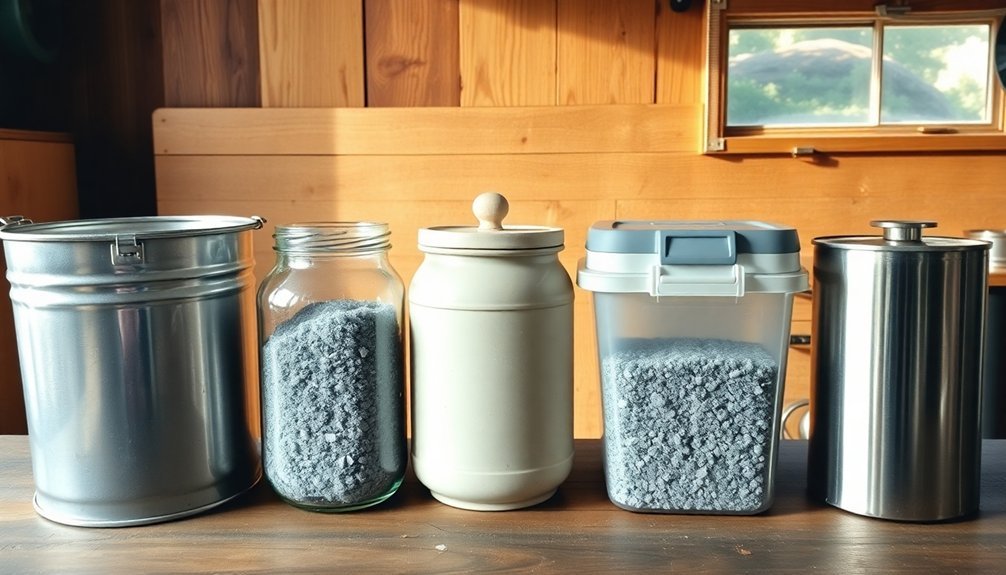
The choice of container material greatly impacts how safely and effectively you can store wood ash. Earthenware and ceramic containers are your best options, as they provide a non-reactive environment and can be properly sealed to maintain ideal storage conditions.
While metal containers might seem sturdy, you'll want to avoid aluminum due to chemical reactions, and other metals need special coating to prevent interaction with the ash.
You shouldn't use plastic containers since they can degrade and leach chemicals into your stored items. Similarly, wooden and cardboard containers don't offer adequate protection against moisture and environmental factors, making them unsuitable for long-term storage.
- Traditional ceramic containers have been used successfully for generations by cultures like the Cherokee.
- Stainless steel containers can work if they're properly lined with non-reactive material.
- Earthenware provides natural breathability while maintaining proper sealing.
- Ground storage using ceramic containers combines traditional methods with effective preservation.
- Non-reactive containers help preserve both the wood ash and any food items you're curing.
When selecting your storage container, prioritize non-reactive materials that can be sealed effectively and will maintain their integrity over time. Earthenware and ceramic options consistently prove to be the most reliable choices for wood ash storage.
Outdoor Storage Requirements
You'll need to place your wood ash container in a secure location at least 50 feet away from water sources and on level, packed soil or a protective pad.
To shield your ash from rain and wind, position the container under an overhang or use a weather-resistant cover that prevents moisture from seeping in while allowing necessary ventilation.
It's crucial to surround your storage area with a small earthen berm to contain any potential runoff and prevent environmental contamination.
Secure Location Placement
Proper placement of wood ash containers plays a critical role in maintaining household safety. You'll need to position your ash container at least 10 feet away from any combustible materials, including your home's walls and firewood piles.
Select a location with a non-combustible surface, and never store ashes on wooden decks or inside garages where they could pose a fire hazard.
When choosing your storage spot, consider both safety and environmental factors. Keep your container away from wells, surface water, and areas where animals drink.
If you're in a karst area or location with high soil erosion, create wider buffer zones to protect water sources. Don't forget to establish a three-foot "kid-free zone" around your ash storage area.
- Place your container where children can't easily access it
- Verify the container isn't blocking any emergency exits
- Position it away from areas with standing water
- Keep it off wooden surfaces and away from deck areas
- Maintain clear access for easy monitoring and disposal
Your container location should balance accessibility for maintenance while maintaining safe distances from both structures and water sources.
Weather Protection Essentials
After securing your ash container's location, protecting it from weather elements becomes your next priority. You'll need to shield your wood ash from moisture, which can make it corrosive and cause unwanted caking. Select a container with a waterproof, tight-fitting lid and place it on packed soil or a protective pad with a small berm around it.
Wind protection is equally important for your ash storage. You'll want to prevent ash dust from becoming airborne, which can create both health and combustible dust hazards. Choose a sheltered spot that blocks prevailing winds, and make certain your container has secure seals to keep dust contained.
If you're storing ash outdoors, you'll need to avoid areas prone to flooding or high ground water. When you're moving your ash containers, always keep them covered to prevent dust dispersal. If the ash becomes too dry and dusty, you can add a small amount of moisture – but don't overdo it, as excess water will cause caking problems.
During periods of expected heavy rainfall, you'll want to make sure your storage area remains well-drained and elevated to prevent water infiltration.
Container Durability Standards
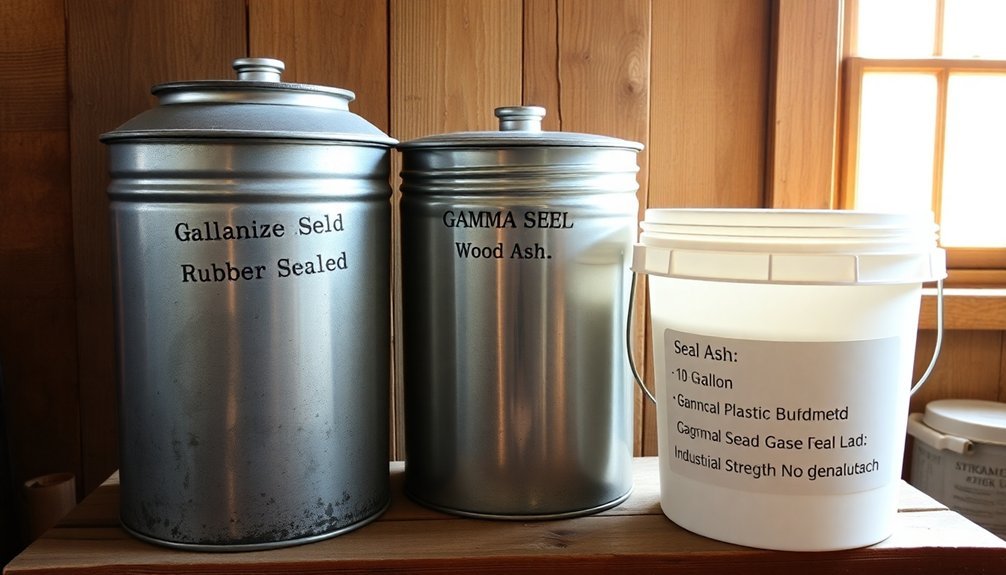
Durability standards for wood ash containers focus on both structural integrity and safety compliance.
You'll need a container that's built to withstand not just the weight of ashes but also potential moisture exposure and temperature variations. Metal containers are mandatory, as they're non-combustible and can handle high temperatures while maintaining their structural integrity over time.
Your container must meet these essential durability requirements to guarantee safe ash storage:
- Metal construction that won't deteriorate from moisture or temperature changes
- Tight-fitting lid mechanism that remains functional after repeated use
- Structural strength to support the full weight capacity when filled with ash
- Corrosion-resistant properties to prevent degradation over time
- Impact-resistant design to withstand normal handling and transportation
When selecting your container, verify it's specifically designed for ash storage and meets applicable safety standards.
The container should maintain its integrity even when exposed to outdoor elements, as proper storage requires placement on non-combustible surfaces away from flammable materials.
Remember that durability isn't just about the container's longevity – it's essential for maintaining safety standards throughout the ash storage period.
Safety Features To Consider
Beyond the container's structural requirements, specific safety features play an essential role in preventing accidents and fires during ash storage. You'll need a container with a tight-fitting lid that prevents airborne ash dust and keeps moisture out. The lid should seal completely but allow enough ventilation to prevent pressure buildup.
Look for containers with raised bases or feet that keep the bottom off the ground, reducing heat transfer to combustible surfaces. You'll want handles positioned on opposing sides for stable carrying and safe transport. If you're storing ashes outdoors, choose a container with weather-resistant features to prevent water from mixing with the ash.
When selecting your container's placement, you'll need to maintain at least 10 feet of distance from buildings and keep it away from wooden structures, firewood piles, and other flammable materials.
Create a three-foot clear zone around the container to prevent accidental contact with combustibles. Make sure the container isn't in an enclosed space and stays away from heating appliances or other heat sources.
These safety features, combined with proper monitoring and handling procedures, will greatly reduce fire risks during the ash curing process.
Air Circulation Design Elements
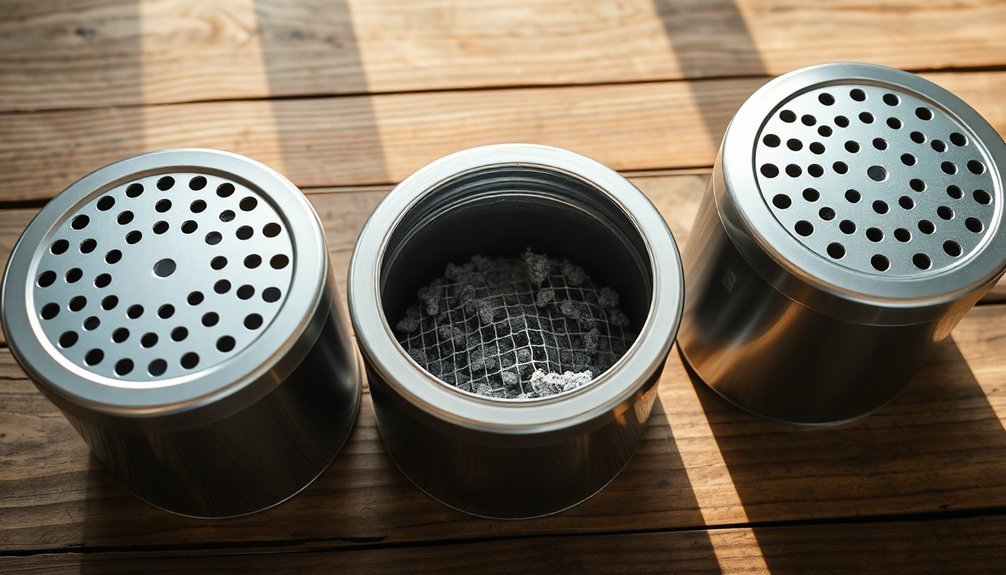
Your wood ash container requires strategic ventilation port placement with holes positioned at both the upper and lower sections to create a natural convection flow.
The lid's design should incorporate mesh-covered breathing slots that let air pass while keeping ash particles contained, working in harmony with the container's primary ventilation system.
You'll want to engineer the internal airflow path by placing baffles or directing vents at angles that promote consistent air movement without allowing moisture to collect in any one area.
Ventilation Port Placement Design
When designing ventilation ports for wood ash containers, it's important to recognize that traditional ventilation systems aren't necessary or recommended.
In fact, you'll want to focus on keeping your ash container securely covered to prevent any risk of re-ignition or unwanted dispersal. While proper air circulation is essential for drying lumber, it's not a primary consideration for storing wood ash.
Your main priority should be selecting a metal container with a tight-fitting lid that keeps the ashes contained and protected from external elements. You don't need to worry about adding ventilation ports, as the emphasis is on containment rather than airflow.
- Place your sealed ash container on a non-combustible surface like cement or brick
- Keep the container at least three feet away from any flammable materials
- Choose a metal container with a secure lid that's large enough for your needs
- Avoid modifying containers with additional holes or ports that could compromise safety
- Regularly check your container for any signs of moisture or heat, which could indicate potential re-ignition
Air Flow Path Engineering
The engineering of air flow paths in wood ash containers requires careful consideration, but it must be emphasized that traditional ventilation systems aren't suitable for ash storage. You'll need to design paths that maintain consistent airflow while preventing moisture buildup and ash disturbance.
| Design Element | Implementation Strategy |
|---|---|
| Air Direction | Create one-way flow paths to prevent stale air recirculation |
| Flow Velocity | Maintain low-speed, steady airflow to avoid ash disturbance |
| Channel Design | Install smooth-walled ducts with minimal obstructions |
| Air Mixing | Position inlets to promote gentle mixing of fresh and existing air |
When you're engineering the flow path, focus on incorporating ventilation channels that distribute air evenly throughout your container. You'll want to integrate small fans if you're dealing with larger containers, but make sure they're operating at low velocities. The key is creating a steady flow that won't disturb the ash while still providing adequate circulation.
Pre-heating incoming air can greatly improve your container's performance, particularly in humid conditions. You should also consider adding protective features around ventilation ports to shield them from wind interference, which could otherwise disrupt your carefully engineered airflow patterns.
Lid Structure For Breathing
Proper lid design balances essential airflow requirements with safety considerations when storing wood ash.
You'll need a tight-fitting lid that prevents moisture infiltration while allowing minimal ventilation to avoid potential dust explosions. The lid structure should maintain dry conditions inside the container but shouldn't create a completely airtight seal that could lead to pressure buildup.
When selecting or modifying a container lid for wood ash storage, keep these key features in mind:
- Use a lid with a secure closure system that won't accidentally pop open during transport or handling
- Consider installing small ventilation holes near the top edges, covered with fine mesh to prevent dust escape
- Choose a design that overlaps the container rim to prevent rainwater from seeping in
- Look for lids made of corrosion-resistant materials that can withstand the alkaline nature of wood ash
- Verify the lid can create a sufficient seal to prevent dust clouds from forming during movement
Your lid's design should prioritize both safety and functionality, minimizing moisture exposure while maintaining enough airflow to prevent dangerous conditions from developing.
Remember to keep the lid closed when not actively adding or removing ash.
Temperature Control Mechanisms
Maintaining effective temperature control serves as a cornerstone for both wood drying and ash formation processes.
When storing wood ash, you'll need to take into account temperature mechanisms that prevent unwanted chemical reactions and preserve nutrient content.
You should choose containers that can withstand temperature fluctuations between 350°C and 500°C during the initial ash formation process. It's essential to let the ash cool completely before storage to prevent container damage and maintain stability of compounds like calcium carbonate and potassium carbonate.
Your container should include thermal insulation properties to minimize temperature variations that could affect the ash's chemical composition.
To prevent nutrient loss, you'll want to keep your stored ash at moderate temperatures, as excessive heat can lead to volatilization of important elements like potassium and sulfur.
Storage containers should be equipped with temperature monitoring capabilities or placed in temperature-controlled environments.
Think about using double-walled containers or those with built-in thermal barriers to maintain consistent temperatures. This helps preserve the ash's beneficial properties for soil amendment and guarantees you're getting the maximum value from your stored wood ash.
Container Placement Strategies
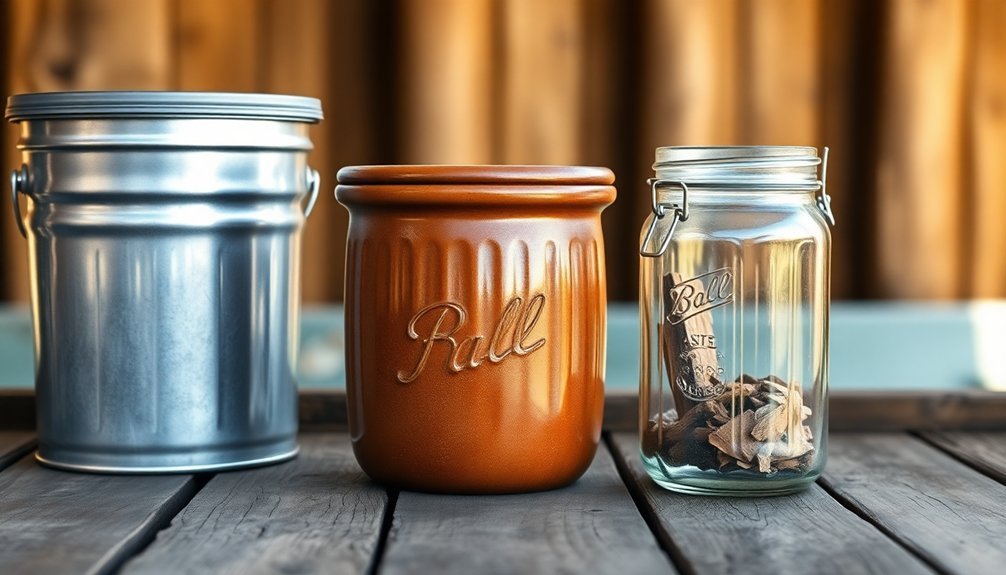
Strategic placement of wood ash containers plays an essential role in maintaining safety and environmental protection. You'll need to position your container several feet away from any combustible materials to prevent fire hazards.
When choosing a location, verify it's at least 50 feet from farm ditches, wells, or water bodies, and increase this distance to 100 feet in highly erodible areas or zones without riparian vegetation.
For best protection, place your container on packed soil or a padded area surrounded by a small berm. If possible, store it indoors to shield it from weather elements.
In areas with unique geological conditions, such as karst regions, you'll need to follow additional local ordinances for proper placement.
Key placement considerations to remember:
- Position containers away from areas where water accumulates
- Keep storage areas accessible but secure from wildlife interference
- Choose a location protected from strong winds
- Verify the storage area has proper drainage
- Select a spot that allows for easy monitoring and maintenance
When dealing with inclement weather, prioritize indoor storage or use protective covering to prevent runoff and maintain the ash's quality.
Rust Prevention Methods
For effective rust prevention in wood ash containers, metal selection and protective coatings play an essential role.
You'll need to choose containers made of materials that won't react with the ash's alkaline properties. If you're using metal containers, apply a non-reactive coating to the interior to prevent corrosion and extend the container's life.
When you're handling wood ash, you'll want to minimize moisture exposure, which can accelerate rust formation. Always wear proper PPE, including gloves and goggles, and consider using a NIOSH-approved respirator if dust levels are high.
You can reduce dust by lightly dampening the ash with water mist during transfer operations, but don't oversaturate it.
To protect your containers from rust, you'll need to store them properly. Place them outdoors on cement or brick slabs, keeping them at least three feet away from any combustible surfaces.
Make certain you're maintaining good ventilation in the storage area to prevent moisture buildup. If you're using plastic containers for temporary washing or glaze preparation, transfer the ash to appropriate metal storage containers once you're done to guarantee long-term preservation.
Container Maintenance Tips
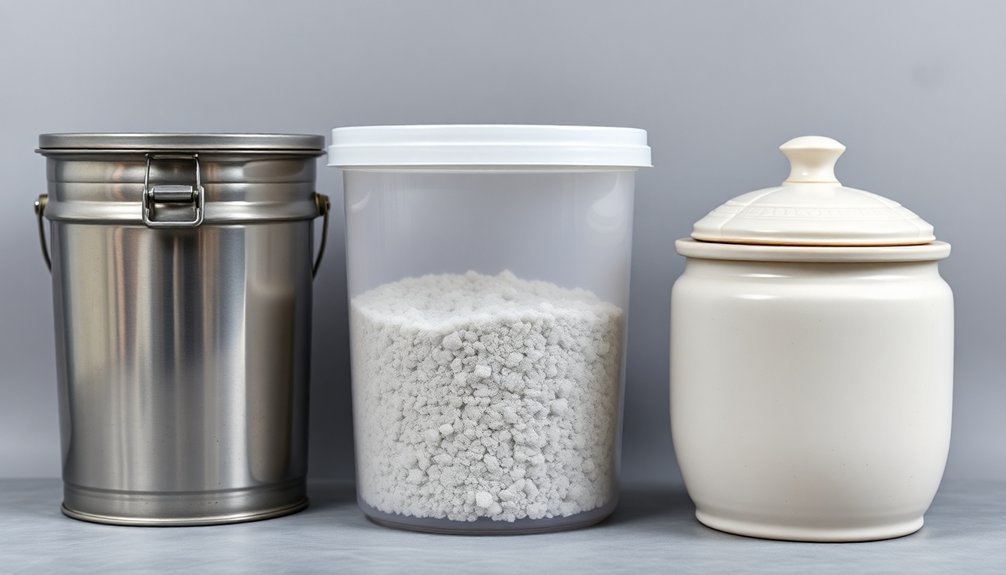
Proper container maintenance extends the life of your wood ash storage and guarantees safe handling. You'll need to check your containers regularly for damage and rust spots, as these can compromise their integrity and lead to ash leakage.
When you're cleaning out your firebox, use a brush or slotted shovel to gather the ashes efficiently, making sure you don't miss any residual material that could cause problems later.
To maintain your ash containers effectively, make certain you're following these essential practices:
- Clean your containers periodically to prevent excessive ash buildup that could affect their functionality.
- Keep the lid tightly sealed when not in use to prevent ash from spreading and moisture from getting in.
- Transfer ashes from your small collection pail to the larger metal garbage can frequently to avoid overflow.
- Inspect the container's handles and seals regularly to make certain they're working properly.
- Remove any spilled ash immediately from around the container to maintain a clean, safe storage area.
Remember to wear protective gear like gloves and a face mask during maintenance tasks, and always verify the ashes have completely cooled before handling them for cleaning or transfer operations.
Frequently Asked Questions
Can Wood Ash From Different Types of Trees Be Mixed in Containers?
Yes, you can mix ash from different tree types in containers, but don't include treated timber ash. Remember that young wood has more potassium than old wood, and avoid mixing in coal ash.
How Long Does Properly Stored Wood Ash Remain Effective for Curing?
When you store wood ash properly in a metal container with a tight lid, it'll remain effective for curing up to one year. For best results, you should use it as soon as possible after collection.
Will Storing Ash in Recycled Food-Grade Containers Affect Its Properties?
You shouldn't store ash in recycled food-grade containers. They won't affect ash properties directly, but they're unsafe due to combustibility risks and lack of insulation. Use metal containers with tight-fitting lids instead.
Does Exposure to Artificial Light Impact Wood Ash Quality During Storage?
You don't need to worry about artificial light affecting your wood ash quality during storage. It won't impact the chemical stability, physical properties, or biological composition of the ash while it's being stored.
Can Electromagnetic Fields From Nearby Equipment Affect Stored Wood Ash Properties?
You don't need to worry about electromagnetic fields affecting your stored wood ash. The ash's properties remain stable regardless of nearby equipment. Just focus on keeping it dry and covered in appropriate containers.
In Summary
Store your wood ash in galvanized metal containers with tight-fitting lids to maintain freshness for curing. You'll want to keep the container in a dry, covered area and check regularly for any moisture buildup or rust. By following proper storage guidelines and performing routine maintenance, you'll extend your ash's usefulness. Remember to choose appropriately sized containers based on your needs and replace lids if they become damaged.





Leave a Reply